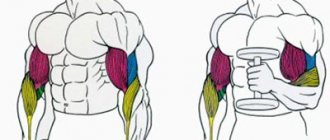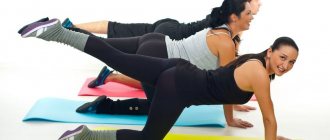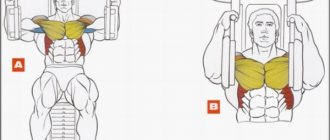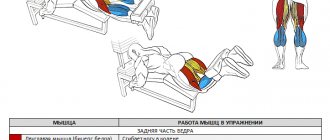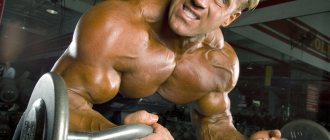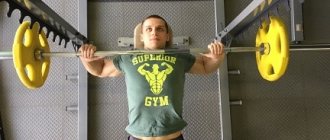Author: Nikolay Borisov - coach, Russian champion in powerlifting Place in the ranking of authors: 14
(become an author) Date: 2017-06-03 Views: 14,959 Rating: 4.9
| All articles by the author >> | Medals articles >> |
Articles are loading...
Visit the website of the author of this article
What are simulators made for?
Initially, the simulators were supposed to help people with disabilities. For example, it is very difficult for a person with poor coordination due to a congenital disease to learn how to squat with a barbell. Smith's frame will allow him to squat, greatly reducing the risk of falling. If someone manages to break an ankle or two, the simulators will allow you to train your casted legs by doing roll-ups and fly-outs.
Sometimes healthy athletes need exercise machines to work out lagging muscles in isolation. The simulator may also be needed for “finishing”. When, after 6-7 sets of pull-ups, you can no longer do even five repetitions, block pulls from above will help out, you can do another 2-3 sets of 10-12 times.
However, over time, exercise machines began to be used instead of free weights in cases where their effectiveness is negligible.
Why fitness trainers love exercise machines.
1.
You can sit or lie on them and take selfies.
2.
The technique of exercises on simulators is an order of magnitude simpler than the technique of exercises with free weights.
3.
It is easier to rearrange the weight on a machine than on a barbell.
4.
The fitness person thinks that a modern simulator is the pinnacle of engineering that will bring him closer to his desired goal.
5.
You can feel cool by pulling all the tiles. Nothing will work with a barbell loaded to the brim.
Why instructors love simulators.
1.
Less time will be spent teaching the client the technique of the exercises than doing exercises with free weights.
2.
Less risk of injuring clients.
3.
There are fewer discs and dumbbells scattered around the room.
About efficiency.
If you have not been involved in physical education and sports for a long time, perhaps the coordination of your movements is not sufficient to work with free weights and it is more advisable to start with exercise machines. When you start exercising on machines, you will feel muscle pain in the first weeks. This means your muscles have received sufficient load. But already in the second month of training on simulators, the effect becomes less noticeable.
Of course, some simulators are necessary for a full workout. As a rule, these are the simplest of them: upper and lower blocks, hyperextension machines. There are successful machines that simulate a seated press, which work the front delts better than with free weights. There are also other useful devices. However, most of the “furniture” in fitness centers only distracts people from proper training.
If the goal of your training is to lose weight: exercises with or without free weights, just with your own weight, will allow you to burn more calories, since they involve more muscles due to their complexity, compared to exercise machines.
If the goal of your training is to gain muscle mass: the criterion for the effectiveness of the exercise is the degree of pain 2-3 days after training. Feelings during exercise and in the evening after exercise can be deceiving. Microtraumas of muscle fibers cause long-term pain, sometimes up to 5-6 days. It usually begins the next day after training, sometimes after 2-2.5 days.
Based on this, you can independently determine the effectiveness of each exercise. For the purity of the experiment, you need to perform only one exercise on a given muscle in 5-6 approaches close to failure and observe the sensations in the muscles for several days.
The experiment with each exercise must be repeated at least 3 times, sometimes the muscle is not pumped for unknown reasons, the body is a complex thing.
Dangerous exercises in bodybuilding [edit | edit code]
When performing isolated exercises on certain muscles, rough and unnatural movements are made for normal life, which over time can result in injury to joints, ligaments and the spine.
If you want to make your training safe, some experts recommend replacing dangerous exercises with safer ones:
EXTENSION OF THE KNEES ON THE SIMULATOR [edit | edit code]
Muscles involved:
Quadriceps
Danger:
Extensions pump up the quadriceps very effectively, but when performing the exercise, unnatural movements are performed that are not characteristic of normal walking. You can put dangerous stress on the ligaments and tendons surrounding your kneecap.
Technique:
Stand on a bench or step platform. Stretch one leg forward, bend the other (supporting) leg slightly at the knee. Moving your pelvis back and without lifting the heel of your supporting leg from the bench/platform, squat down and return to the starting position. You can lower your free leg slightly below the level of the bench. If you find it difficult to maintain balance, throw a towel over the stationary horizontal part of the nearest exercise machine and hold on to it (preferably with one hand).
BODY ROTATION ON THE SIMULATOR [ edit | edit code]
Muscles involved:
abdomen with emphasis on obliques
Danger:
When performing this exercise, the pelvis rotates in the opposite direction from the movement of the chest, which is not only unnatural, but also extremely dangerous for the lumbar spine.
Alternative:
row with twisting on the upper block
Technique:
Stand with your right side facing the block machine. Grasp the rope handle attached to the pulley with both hands, bend your knees slightly and tighten your core muscles, locking your lower back. Pull the handle to the side and down towards your left knee. Return to starting position and repeat. Do 12-15 repetitions for each side.
HIP ABDUCTION ON A TRAINER [edit | edit code]
Muscles involved:
Gluteal
Danger:
Regularly performing this exercise, especially with heavy weight, can result in injury to the back or hip joints.
Alternative:
lunges with expander
Technique:
Place the loops of the resistance band around your ankles, tighten them well, and begin performing side steps. This exercise is not as easy as it seems at first glance.
SEATED BAR PRESS [ edit | edit code]
Muscles involved:
shoulder girdle
Danger:
It is much more common for the body to lift something heavy overhead by engaging additional muscles. And this exercise turns off the thigh and core muscles from work, which causes dangerous overload of the shoulder joints.
Alternative:
Medicine ball throws (special heavy ball for fitness)
Technique:
Stand a meter from the wall, lift the ball to your chest and throw it up so that it hits the wall at a point that is about 1 meter above your height. Catch the ball by crouching a little, then straightening your legs, repeat the exercise. In this variation, the shock-absorbing movement of the hips will reduce the load on the shoulder joints.
SQUATS ON THE SMITH MACHINE [edit | edit code]
Muscles involved:
legs
Danger:
On this machine, the bar moves along a given path, which means that there is a greater load on the knee ligaments, shoulder joints and lower back, since instead of a naturally curved path, the Smith machine forces the bar to move in a straight line.
Technique:
Place the barbell on your front deltoids and, with your feet slightly wider than shoulder-width apart, squat down. The hardest part is maintaining your balance, so don't lean forward and keep your elbows higher. The exercise is certainly more difficult, but much safer for the lower back.
LEG PRESS ON A MACHINE [edit | edit code]
Muscles involved:
thighs and shins
Danger:
This exercise is performed with bending of the back without the participation of the muscles responsible for its stabilization; these muscles, like a strong frame, fix the lumbar, thoracic and even cervical spine.
Technique:
Place your feet slightly wider than your shoulders and squat as deeply as possible until your knees begin to go beyond the line of your toes, without rounding your back. Start with 15-20 repetitions per set, varying the number of sets and reps as you go, depending on your goals.
RISES ON A ROMAN BENCH [ edit | edit code]
Muscles involved:
Hip flexors and abdominal muscles
Danger:
Raising the body loads the lower back precisely when it is in its most vulnerable, rounded position.
Alternative:
Front bar
Technique:
Stand on your elbows, straightening your body and hips in one line. Pull your stomach in and tighten your buttocks. Hold the position for 30 seconds.
SEATED VERTICAL PULL [ edit | edit code]
Muscles involved:
back and shoulders
Danger:
The vertical row is very difficult to do correctly. It only seems that it is very comfortable, but beginners very often make mistakes with the weight, as a result, people with insufficiently developed flexibility (almost all beginners) experience dangerous injuries to the shoulder joints.
Alternative:
Low bar pull-ups
Technique:
Secure the bar to a power rack or Smith machine at waist level (or a little higher if you've been training recently). Grasp the bar with a wide grip and, having climbed under it, hang with your feet far forward and your body straightened in line with your legs. Pull yourself up, spreading your elbows out to the sides and trying to touch the bar to your lower chest.
HYPEREXTENSION ON A ROMAN BENCH [edit | edit code]
Muscles involved:
Spinal extensors
Danger:
Extending the spine under load can cause vertebral displacement, although hyperextension may be beneficial in some cases.
Technique:
Get on all fours, stretch your right arm forward and your left leg back. Hold for 7 seconds and repeat. Do 10 repetitions for each leg and arm. This exercise is safer for spinal diseases.
ARM CONCLUSION ON THE EXAMINER [ edit | edit code]
Muscles involved:
Breasts
Danger:
This simulator puts the shoulder joints in a very unstable position, and the effectiveness of the exercise, as practice shows, is not great.
Technique:
Take a lying position with your feet on the bench. Do push-ups, trying to do 10-15 repetitions per set.
Side squat versus leg abduction and abduction on the machine
Leg raises and leg raises while sitting on a machine are very popular with many ladies. The more love, the less effect. As a rule, unloved exercises develop lagging muscle groups.
Side squats directly target the adductors, abductors, hip extensors, hip flexors, and glutes. The exercise is very energy-intensive.
Many people call it lateral lunges. However, “lunge” is a fencing term. The lunge involves bending the knee to 110 degrees. When squatting, the knee should bend up to 40-50 degrees; those with flexibility can rest their buttocks on the heel. The greater the amplitude, the higher the efficiency. In the lower phase, the heel of the supporting leg can be lifted off. Stepping out onto your toes will allow you to achieve a smaller angle at the knee.
Before doing the side squat, warm up well with a regular squat. Self-massage of the knees will not hurt; it will speed up the warming up of the joints. The legs must be placed at such a width that the knee of the free leg in the lower position is bent by 160-170 degrees. Keeping the joint straight (180 degrees) is dangerous. You need to go down smoothly (slower than you get up) to avoid injury. Try to keep your body closer to the vertical, your hands behind your head, an easier option is your hands in front. Look forward and up.
When you can do 4 sets of 10 pairs (a pair is a squat on the left and right leg) of squats, place the bar on your back and gradually add weight, without sacrificing technique.
If you are not able to do 6-8 pairs of squats without weights, stand in front of a wall bars or some kind of machine. Grab the bar or the rack of the machine with your hands, and do a side squat, helping yourself with your hands.
Your legs and buttocks will change for the better much faster than those of your friends who continue to move their legs on exercise machines.
Using a Seated Leg Curl Machine
Why? It seems like it should help you get rid of fat on your outer and inner thighs. But alas, this is not so. Exercises that target only one part of the body will not help you lose weight.
What to replace it with? Lunges forward, backward and to the sides. These exercises will tone and make your entire body, including your hips, stronger. Plus, they're more practical and give you more endurance for everyday life (unlike a machine, according to Greg Justice, owner and founder of AYC Health & Fitness in Kansas City).
Ab exercises
Why? Simply because they are not that effective. Research has confirmed that abdominal exercises are less effective at stimulating muscle fibers than exercises aimed at stabilizing the spine (planks).
What to replace it with? Plank (read “Keeping the Plank: A Set of Simple and Effective Exercises for a Beautiful Body”). By doing this exercise, you will use more core muscles than an ab crunch. In addition, doing a plank will prevent you from straining your back.
Leg bending on a machine from a lying position
Why? When you do exercises lying down, your spine is not involved, and you train the least amount of muscles. In addition, such an exercise turns out to be useless in real life: it is unlikely that anyone can name at least one reason why we need to bend our legs from a lying position.
What to replace it with? Raising the leg back from a standing position. This exercise activates the posterior part of your body, which includes your lower back, glutes, thighs, and calves, while also working your core muscles to maintain balance. Most importantly, this exercise develops the flexibility and balance skills necessary in everyday life.
Tricks of execution
To get maximum effect, it is recommended to adhere to the following rules:
- While performing, hold the handles of the machine firmly.
- Under no circumstances lift your pelvis from the arch of the benches.
- Bend your legs until they are almost completely in contact with your buttocks.
- To maintain the load on the muscles, do not fully straighten your knees when they are at their lowest point.
- The upward movement is slightly faster than the downward movement.
- Do not slide your hip or pelvis on the bench.
- Make sure that your knees do not hang over the bench.
- Stretch your hamstring after completing each set.
Remember, it is strictly forbidden to perform this exercise if you have a medium or large belly.
Dumbbell arm extension
Why? You won't be able to lift a heavy enough weight and still maintain proper arm position. Usually the shoulder begins to sag and the effectiveness of the exercise is lost.
What to replace it with? “Skull crusher”, or French bench press for triceps. The exercise will allow you to pump up your triceps muscles without losing the shape of your arms. The skull crusher position allows your elbows to remain where they should be and thus receive the necessary load.
Calf raises while standing on the machine
Why? The machine puts all the weight on your shoulders, which puts stress first on your back and then on your calf muscles.
What to replace it with? Sprint. It's better than regular running for developing your calves. Sprinting activates more fast-twitch muscle fibers, which are responsible for muscle growth and development.
If sprinting isn't for you, try calf raises using your body weight. If this seems too easy for you, then try doing this exercise on one leg.
Three exercises that kill your knees
Here's what you need to know.
A seated leg extension machine puts excess stress on the knees. Use the blood flow restriction technique to increase intensity by creating cumulative stress on the muscles under less load.
Classic lunges cause knee pain for many people. Replace them with static lunges or back lunges to reduce stress on your knees and activate your glutes.
Running kills your knees. Replace it with walking on an inclined moving track or add variety with accelerated sprints.
If your favorite exercises are harmful to your health, change them to others. Or at least try these modifications. Here are three alternatives to some of the most common knee-damaging exercises.
1 – Seated leg extensions
The seated leg extension machine has been criticized repeatedly by the fitness industry over the past twenty years. It has been accused of creating chronic irritation of the knees due to the high compressive load on the knee joints, which leads to the destruction of the cartilage layer of the heads of the bones. This opinion has been expressed by trainers, physical therapists and biomechanists because it is an “open chain exercise” as opposed to squats or deadlifts. These are all important points, but leg extensions have built many great quads in bodybuilding. They are still the mainstay of many training programs because they produce results for those who crave muscle hypertrophy. So how can you get legs as thick as trees while maintaining healthy knees? By modifying or even replacing it with another exercise that is easier on your knees in the long run.
The best option is split squats with your leg elevated.
Although fatigue of the quadriceps muscle fibers is guaranteed with a seated leg extension machine, the same effect can be achieved with loaded single-leg exercises such as lunges or split squats. Once you've mastered static split squats and earned the right to move forward, try making them more difficult by placing your back leg on an elevated platform. This opens up the potential to create extensive mechanical and metabolic stress on the quadriceps and posterior chain stabilizer muscles, allowing the exercise to become more challenging without losing the quadriceps emphasis that has made seated leg extensions so popular. If you're looking for a way to get as much pain as possible, try this option. The quadriceps will receive such a load that you will forget to even think about leg extensions.
How to Continue Working on the Leg Extension Machine If Necessary
You can continue to work on this machine using the Blood Flow Restriction (BFR) technique. With the correct technique, this will lead to a tremendous increase in muscle mass without increasing the compressive load on the knee joints. Take elastic bandages or straps and pull them up on each thigh so that they are as close to the buttock crease as possible. Make sure you feel your legs about eight-tenths of the way, which is pretty tight. After this, perform high rep sets, such as 15-20 reps, all at 30-40% of your 1RM. Maintain constant tension and pump more and more blood into your quadriceps with each rep. Take short breaks. They should last no longer than 20-40 seconds. The main factor is the cumulative stress of pumping, so don't worry about working at a fraction of your normal working weight.
2 – Alternating forward lunges
Lunges are a fundamental exercise, but the most popular variation, alternating forward lunges, is also the most traumatic. The golden rule is to never use a load (additional weight) during dysfunctional movements. However, most people are unable to properly perform even one bodyweight lunge with proper mechanics. And since there is an opinion that the more the better, the careless form of performing the exercise becomes even worse when additional load is added. Lack of stability in the core and hips leads to a valgus (tight) knee position, excessive knee extension beyond the toe level, use of inertia and the development of compensatory forces, which spreads instability to the back, hips and generally to all joints. The correct thing to do is to correct the shape first. But if the results of your leg day are so dependent on lunges, then there is a simple modification that will help you perform lunges without unwanted compressive stress on your kneecaps.
The best option is static split squats.
The forward lunge is a dynamic movement that involves stepping forward, lowering down, and then returning to a neutral position. A dynamic movement that often leads to injury can be simplified to a static variation. Static split squats are a good substitute for forward lunges until you've mastered the technique for the latter. Place your feet in a wide split position. If the position is stable, you can lower one knee to the floor into a half-squat position when the angle between your hips and knees is 90 degrees. You can now perform full-range split squats on one leg. They will target the same muscles as dynamic squats, but will keep errors in technique to a minimum.
Common mistakes
The following errors are often encountered when performing such exercises:
— an incorrectly configured simulator, that is, before performing the approach, beginners forget to select the necessary parameters specifically for their height. Such a mistake can result in injury;
- an attempt to set a load that is greater than the athlete can do. In the pursuit of progress, do not forget that the correct execution technique should come first. Very heavy weights cannot be done with a full and technically correct amplitude, as well as concentrate and isolate the load on the desired muscle group.
When performing these exercises technically correctly, using the techniques described in the article, you can achieve improved results in basic squats, leg presses, and also give a more beautiful and aesthetic appearance to your legs. Remember that good and proper intensity of leg training has a positive effect on the production of the hormone testosterone. It, in turn, promotes faster recovery and growth of muscle mass.
Dangerous exercises in the gym that you should cross out from your program
The life hacker tells you which exercises and machines in the gym can be harmful to your health, and offers several safe alternatives.
Sometimes regular strength training not only does not give the desired result, but can also harm your figure and health. Often the reason lies in ineffective and even dangerous exercises.
It is better to include these complexes in your program under the supervision of a professional trainer and in case of good physical fitness: with developed muscles and mobile joints, as well as with well-established technique, the given exercises are much safer.
Well, if you lead a sedentary lifestyle and you don’t have the opportunity to work out with a trainer, you should completely cross them out of your workout, replacing them with safer exercises for developing the same muscle groups.
Single leg squat vs leg press and machine leg extensions
In point one, we dealt with women's love. The leg press is a man's love. You can hang 4 hundred and feel like a hero. Will this hero squat 200 so that he would be counted in competitions? Will his legs be bigger than those who diligently squat 150-180?
You can see guys with huge quadriceps on the leg extension machine. Imitating them, many beginners include extensions in their program, without thinking that the quadriceps did not grow from extension. Have you seen a person who, without doing squats, pumped up his thigh by bending and extending his legs? There are many counterexamples: large muscular thighs in athletes who did not do flexion and extension. Tens of thousands of such beautiful thighs existed even when there was not a single simulator for bending or extending legs on the territory of the USSR.
You can train your legs only with barbell squats, but this idea has its drawbacks. When working to failure, the technique is violated, which is fraught with injuries. Doing too many sets of squats can lead to overtraining and back problems, which is tough on the psyche. Additional exercise needed.
The one-leg squat works the entire thigh, glute, and all! Doesn't put any strain on your back. Successfully replaces the leg press, flexion and extension combined, saving time and increasing efficiency. A trained athlete needs to hold a dumbbell in his hand. In one gym near Moscow, where many people practice squats on one leg, some women hold up to 16 kg in each hand; they have mastered the exercise so that they do not need to hold onto a support with their hand. Many of them have fulfilled the MS standard in the FPR.
Abdominal exercises
According to Dr. Stuart McGill, a professor at the University of Waterloo and a world-renowned specialist and expert on back biomechanics, doing crunches puts a lot of stress on the back and leads to injuries and problems with the lower back, in particular bulging spinal discs.
Based on research, Dr. McGill concludes that the lower back has a certain limit of flexion and extension, after which the tissue wears out and the risk of injury increases greatly.
Raising the torso
Raising your torso on an incline bench or on the floor is considered a dangerous exercise for the lower back. During sit-ups, not only the rectus abdominis muscles are tensed, but also the iliopsoas muscles, which are part of the group of internal pelvic muscles.
The iliopsoas muscles compress the lumbar vertebrae during lifting, and with excessive and constant load during crunches (while working out at home, many like to set personal records: 3 sets of 30–40 times, until the abdominal muscles fail), the pressure on the vertebrae increases, which threatens lumbar injuries.
In addition, body lifts are contraindicated for people with sedentary work. During the day, due to the sitting position and tilt of the body forward, the anterior part of the lumbar spinal discs experiences serious stress.
During lifting, you load them even more: the front part of the discs is compressed, and the back part is stretched and injured. Therefore, after repeated repetitions, people often feel pain in the lumbar region.
An excellent replacement for dynamic exercises is the plank with isometric abdominal tension. This exercise eliminates compression of the spine and numerous bends and at the same time perfectly trains the rectus abdominis muscles.
Crunches
Ab crunches do not involve a full lift of the body, so this exercise can be considered more gentle on the lower back. However, this reveals another problem - excessive tension in the neck and shoulders.
In addition, by twisting, you shorten the rectus abdominis muscle, which performs not only the function of flexion and extension of the body, but also its stabilization. The shortened abdominal muscle pulls the chest down, the shoulders drop, and the head comes forward.
Leg raises
You should not perform this exercise if you have weak rectus abdominis muscles. When you perform leg raises, part of the load is placed on the iliopsoas muscle.
With undeveloped abdominal muscles, the iliopsoas muscle becomes excessively tense and pulls the spine along with it. As a result, you may experience displacement of the lumbar vertebrae.
Therefore, before performing this exercise, it is necessary to strengthen the rectus abdominis muscles.
Twisting with a side turn
This exercise is considered especially effective for pumping up the oblique abdominal muscles, but it is quite dangerous for the spine. Just as during sit-ups, the front part of the spinal discs is compressed, and turning the body increases the load.
Leg bending in the simulator while lying on your stomach
Various exercises are used to build leg muscles, and each of them has its own advantages and disadvantages. If we consider such a process as bending the legs on a lying machine, photos can clearly show all the features of its implementation. This exercise is considered the most effective and simple.
In terms of effectiveness, it is in no way inferior to bending in a sitting position, but there are certain nuances here, and in order to understand which type will be better in a particular case, a comparative analysis needs to be carried out.
- A sitting position reduces the load from the machine, while a lying position increases it.
- When sitting, there is a need to control the range of motion. If it is not exercised, the load will be removed from the target muscle. This increases the risk of knee injury.
- When sitting, there is no pressure on the stomach, so the breathing process is natural and not difficult, which has a beneficial effect when working with weights.
- If effective correction of the inner thigh is needed, seated curls are used, while lying curls place more stress on the hamstring, namely the inner part.
Exercises for thigh muscles
Reduction and extension of legs
One of the common mistakes girls make in the gym is the frequent use of leg abduction and abduction exercises in order to reduce fat in problem areas.
Let's start with the fact that it is generally impossible to remove fat in a certain part of the body by pumping that part. You can remove fat all over your body, and by pumping up a certain muscle group, you only increase their size.
As for the simulator for pumping up the adductors, it is practically useless (for weight loss, for sure) and even dangerous.
During this exercise, a large load is placed on the piriformis muscles. The strained muscle begins to put pressure on the sciatic nerve, causing piriformis syndrome—pain in the buttock or back of the thigh.
Seated leg extension
This popular machine is designed to train the quadriceps femoris muscle. This movement is extremely unphysiological and does not occur in everyday life (except if you play with a small child, bouncing him on his feet), as a result of which the knee joint is not designed to withstand the load in which a lot of weight is placed on the ankles.
Working out on such a simulator, you risk getting a knee joint injury. And those who have already had knee injuries should not even approach this simulator.
These are more physiological and knee-friendly exercises.
Leg press
This machine is just as dangerous for the knees as the previous one. Here you have to push the heavy platform away from you.
Our bodies are not designed for this type of movement: it does not occur in real life, so it does not help develop functional strength.
In addition, this exercise is dangerous for the back. When you lower the weight, your pelvis twists and puts pressure on your lower back, creating the risk of a bulging disc.
Working with additional weights
When it comes to training your legs using additional weights, the first thing that comes to mind is the barbell squat. This exercise has become a universally recognized classic in the world of physical training. This became possible due to the high level of effectiveness of this exercise and the ease of its implementation. In addition, due to the fact that during its implementation several different parts of the body are involved, it allows for complex training. Also, many athletes resort to performing the previously mentioned lunges, taking additional load in the form of a barbell or dumbbells.
Fitness Place provides athletes with the opportunity to purchase all the necessary equipment to exercise at home, on the street or in the gym in order to get perfectly toned legs.
Arm exercises
Bench press
The shoulder joint is poorly adapted to such a load due to its anatomical features.
When you raise your arm, the acromion, the end of the shoulder blade, rubs against the rotator cuff, causing irritation or damage to its tendons (impingement syndrome).
Acromion and rotator cuff
Raising your arms with dumbbells up
The exercise is aimed at working the trapezius and rhomboid muscles, as well as the triceps and deltoid muscles of the shoulder.
The main load goes directly to the shoulder muscles, so there is a danger of overworking them and getting pinched nerves. In addition, there is the above-described problem with the impact on the rotator cuff and the risk of impingement syndrome.
The dumbbells are raised at arm's length to shoulder level. It is important to avoid rotation of the shoulder joint and lift the dumbbells alternately with your left and right hands, and not with both hands at the same time. This relieves stress on your back.
During this exercise, the arm is not raised so high that it overloads the shoulder muscles. In addition, the acromion does not reach the rotator cuff, which eliminates tendon damage. At the same time, the exercise uses the same muscle groups as lifting dumbbells up: deltoid, trapezius, serratus anterior, rhomboid.
French press
This is another type of non-physiological load that practically never occurs in everyday life. During this exercise, a large load is placed on the elbow joints, which are not ready for this. As a result, the risk of elbow injury increases. Personal experience suggests that this is so: clicking and pain in the elbows necessarily accompanied this exercise.
Calf raise against all machines
I tried training my lower legs on different machines, standing and sitting. I never felt a serious effect. Often due to uncomfortable or slippery foot rests, sometimes for reasons I don't understand.
Only by doing calf raises, standing on a raised platform (with a wooden or rubber surface) against a support (usually a wall bar), I almost always get muscle pain. To do this, you need to follow several rules: smooth lowering, several times slower than lifting; lowering to failure with maximum muscle relaxation; raising the heel to the maximum height and holding it at the top point; changing legs without rest for all sets, usually from 3 to 5. Track and field athletes will need to hang a kettlebell on their belt. Large weights are not needed; as the number of repetitions decreases, the effect of the exercise decreases. Hands should hold onto a wall bars or other support. Otherwise, you will have to think about maintaining balance, which will prevent you from concentrating on the execution technique. For this reason, I consider calf raises with a barbell on the back, which some people demonstrate on the Internet, to be completely unacceptable. Press your free leg close to your working leg to avoid unnecessary vibrations. In the video, I sometimes move it to the side so that you can better see the work of the muscle. The right heel drops less than the left due to the fracture, I’m not messing around.
The exercise should be done in shoes with flexible soles and good grip. Perform the exercise no faster than shown in the video and the lower leg will work.
Back exercises
One of the most traumatic exercises for the spine in the gym is hyperextension. Mostly problems arise due to incorrect technique.
Hyperextension
Hyperextension helps increase the strength of the back extensors and simultaneously engages the trapezius and splenius capitis muscles.
A common execution of hyperextension involves lowering the body completely down, followed by a lift, often with a weight in the hands or on the back. In this version, this exercise is aimed at working out (usually warming up) the hamstrings and gluteal muscles.
Hyperextension to warm up your legs
Excessive use of this version of hyperextension—frequently performed with numerous repetitions and heavy weights—can have a negative impact on the health of the spine. Full forward bending creates excessive compression in the lower spine and provokes lower back injuries.
If you're going to strengthen your back extensors, such as before doing a deadlift, you might want to do hyperextensions differently.
Hyperextension to strengthen back muscles
You start the movement from a position with a straight body and do not go down, but rise up, spreading your shoulders and moving your head back. At the extreme point you need to linger for 6-7 seconds.
Position of the musculoskeletal system during hyperextension/Muscle&Motion
Attention! An absolute contraindication for all types of hyperextensions is an intervertebral hernia on a thin stalk.
Pull-down of the upper block behind the head
This exercise is aimed at working the back muscles: when performed correctly, the main load goes to the trapezius muscles, the teres major muscle and the latissimus dorsi muscle.
Like any exercise that violates the straight position of the spine under load, the overhead pull-down is potentially dangerous; moreover, the neck, the most fragile part of the spine, is involved in its implementation.
Pulling an overhead pulley behind the head requires a person to arch their neck and lean their head forward, thereby breaking the straight line of their back. This can cause strain or strain in the neck and back muscles, or worse, herniated discs.
Pulling the upper block to the chest allows you to keep your head straight without disturbing the straight line of your back. You can also perform lat pulldowns. During this exercise, the trapezius muscles, latissimus dorsi, rhomboid muscles, and teres major muscles are also loaded.
Leg raises on the Swedish wall with support on the forearms
In this exercise, as with sit-ups, the iliopsoas muscles are involved. Due to the fixation of the back (you lean on the bar of the exercise machine), as well as with weak rectus abdominis muscles, the iliopsoas muscles become overstrained and pull the vertebrae along with them, causing their displacement.
In this exercise, while lifting the legs, the pelvis is naturally retracted, due to which the load is redistributed and the iliopsoas muscles are not overloaded.
However, if you are overweight or have weak abdominal muscles, you should first strengthen them with a plank and then move on to this exercise.
This completes the list of dangerous exercises. If you have your own versions of dangerous complexes that led to your injury, share your experience in the comments.
Execution technique
The technique for performing leg raises in the simulator is simple:
- Sit on the bench of the exercise machine and fix your feet on the “pedals”, and rest your feet on the pedals;
- Tighten your stomach, grab the handles with your hands to eliminate inertia;
- Spread your hips to the sides with a simultaneous smooth movement;
- Slowly bring them together, excluding your knees touching each other.
Technical errors include pushing the simulator with a jerk, and bringing it to its original position due to the force of inertia.
There are several variations of the exercise:
- Breeding with a straight vertical back – more emphasis on the gluteus medius;
- Breeding the legs with the body tilted forward allows you to partially load the gluteus maximus;
- Breeches with the body tilted back - with the back completely pressed against the back of the machine - allows people with different body types to perform the exercise comfortably.
